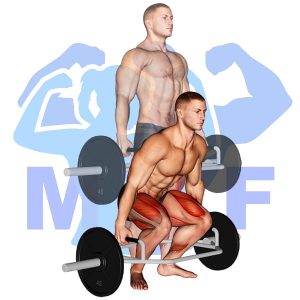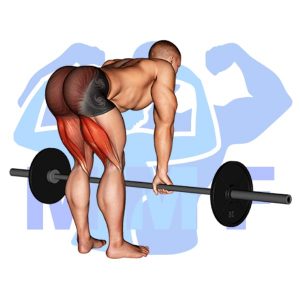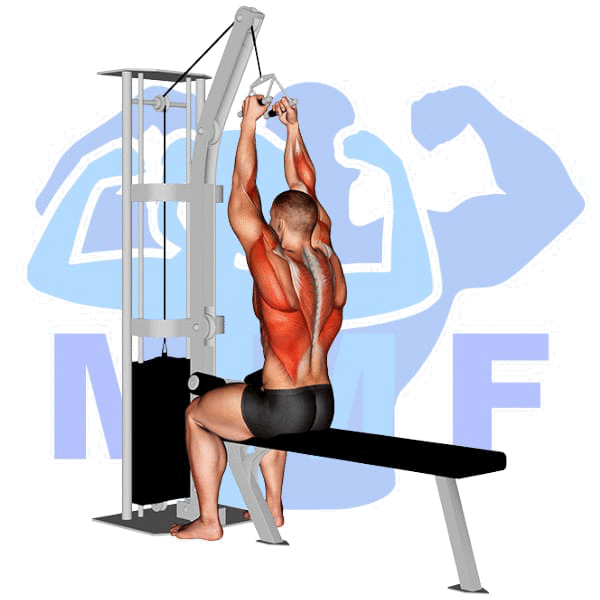Are you struggling to master the barbell deadlift? You’re not alone. Many people find this exercise to be challenging, and it’s easy to understand why. The barbell deadlift is a complex movement that requires strength, coordination, and proper form. It’s no wonder that so many people struggle with it. But don’t worry, there’s a reason for your struggles. With the right guidance and approach, you can master the barbell deadlift and reap its many benefits. In this post, we’ll provide you with tips and techniques to help you perfect your barbell deadlift and take your lifting to the next level.
Barbell Deadlift Summary
- Primary Muscles: Gluteus Maximus
- Secondary Muscles: Adductor Magnus, Quadriceps, and Soleus
- Equipment: Barbell
- Mechanics Type: Compound
- Force: Pull
- Utility: Basic

Barbell Deadlift Instructions
- Stand with your feet hip-width, positioning the bar directly over the middle of your feet. The bar should be about an inch in front of your shins.
- Reach down and grab the bar slightly outside of your thighs with both hands in an overhand grip.
- Note: Many people may prefer a mixed grip when powerlifting, but if you are lifting to build symmetry, you should use the overhand grip with both hands.
- Next, bend your knees and lower your hips until your shins touch the bar, without moving the bar.
- Then, lift your chest and straighten your back and arms while flexing your lats. You should now feel the weight of the bar in your hands.
- Now, breathe in and tighten your core and pull the bar directly off the floor by standing straight up. The bar should be close to your legs that you may drag it across your leg.
- Pause for a second at the top, and breath out. Then lower the bar by sliding it back down your legs and return it to the same place on the floor.
- Repeat until you complete your desired deadlift reps.
Video Tutorial
Barbell Deadlift Muscles
Target (Agonist)
Synergists
- Adductor Magnus
- Quadriceps
- Sartorius
- Soleus
Dynamic Stabilizers
Stabilizers
- Erector Spinae
- Levator Scapulae
- Sartorius
- Rhomboids
- Trapezius – Middle
- Trapezius – Upper
Antagonist Stabilizers

Benefits of Barbell Deadlift
The barbell deadlift is an incredibly beneficial exercise for strengthening the Gluteus Maximus muscle, which is one of the largest and strongest muscles in the body. By performing a barbell deadlift, the Gluteus Maximus is activated and strengthened to help improve overall core strength and stability. Additionally, barbell deadlifts can help improve hip mobility, reduce the risk of lower back injury, and increase overall athletic performance. Furthermore, barbell deadlifts can help to improve posture by strengthening the muscles in the back and glutes. This exercise also provides a great cardiovascular workout as it requires large amounts of energy expenditure and increases heart rate. All of these benefits combined make barbell deadlifts an essential part of any strength training or fitness routine.
Tips for Performing Barbell Deadlift
The Barbell Deadlift is one of the most effective exercises for building strength and power, and you can use it to get fit in no time. To make sure you get the most out of this exercise, here are some tips to keep in mind when doing the Barbell Deadlift.
- Perform Adequate Warm-Up Prior To You Begin Adding Your Weight. Not doing a proper warm-up is the most likely cause of injuries.
- Stay Hydrated. You will have much more energy and recover quicker when you intake water while working out.
- Make Sure That You Make Time For Recovery Days. If you don’t want to recovery you are able to mix up your program with rowing. Just understand to let your muscles to heal, healing is how your muscles grow.
- Do your large compound movements first of your training, next conduct isolation exercises to target distinct muscles afterward. You want the peak results of your individual muscle groups any time you accomplish compound exercises including, squats, deadlift, and bench. After that, you want to focus on the muscle groups of which you determined were weak for those exercises, or areas that couldn’t get fatigued as a result of the type of compound exercise you conducted.
- To Improve Power And Speed, Bring Up The Acceleration Of Your Lift. Maintain good technique or you will be more suboptimal to personal injury. You should reduce the weight to 50 to 60 percent of your single rep max weight when training for quickness. However, you should now pause between every rep.
Benefits and Tips Video
Frequent Mistakes To Avoid
When it comes to the Barbell Deadlift, it is important to execute the exercise properly in order to maximize its effectiveness and prevent any injuries. To ensure that you are performing this exercise correctly and safely, there are certain common mistakes to avoid. In the following section, we will outline these mistakes so that you can make sure you are getting the most out of your Barbell Deadlift workout.
- You Can’t Skip Out On Rest Days. Over-training can easily in fact help to make you weakened rather than bigger.
- It Is Best If You Don’t Execute The Same Lifts Each And Every Time. When people execute exactly the same exercise every exercise session ones muscle groups are going to be taught to undertake that sole physical exercise very well, and you will peak more rapidly.
- Avoid The Urge To Make It To Easy. Your main way to get stronger will be to challenge yourself.
Find More Barbell Exercises Here
Variations and Complementary Exercises
When doing the Barbell Deadlift, there are a few variations, complementary, and alternative exercises that you can use to switch up your routine. These exercises can help you target the same muscles as the Barbell Deadlift, while also providing a different challenge. Here are some exercises to consider:
Band Stiff Leg Deadlift

The Band Stiff Leg Deadlift is a great complementary or alternative exercise to the Barbell Deadlift. This exercise targets the same muscle groups as the Barbell Deadlift, but focuses more on the posterior chain muscles such as the glutes and hamstrings. It also helps to improve flexibility in those muscles, which is important for any strength training program. The Band Stiff Leg Deadlift can be done using either a barbell or with bands and can be done with lighter weights than the Barbell Deadlift, allowing you to work on technique and form while still getting an effective workout.
Trap Bar Deadlift

The Trap Bar Deadlift is a great complementary or alternative exercise to the Barbell Deadlift. It is a variation of the traditional deadlift, but with a different bar shape. The Trap Bar Deadlift puts less stress on the lower back due to its design and allows the lifter to keep the torso in a more upright position. This makes it a great exercise for those looking to increase their strength while avoiding lower back pain. The Trap Bar Deadlift also allows you to use heavier weights than traditional deadlifts, giving you a greater challenge and potential for muscle growth.
Barbell Dimmel Deadlift

The Barbell Dimmel Deadlift is a variation of the traditional Barbell Deadlift that is designed to target the lower body muscles while also providing an extra challenge for the core. This exercise is a great alternative to the traditional Barbell Deadlift as it forces the lifter to maintain a neutral spine position throughout the entire lift, while still working the same muscles as the traditional deadlift. The Barbell Dimmel Deadlift also requires more balance and stabilization than the traditional deadlift, making it a great complementary exercise for those looking to build strength and stability in their lower body.
Check Out These Top Barbell Exercises
Barbell Snatch Deadlift

The Barbell Snatch Deadlift is a powerful exercise that is a great complement or alternative to the Barbell Deadlift. It works the same muscles as the Barbell Deadlift, but in a slightly different manner. The Barbell Snatch Deadlift requires you to explosively lift the weight up, while the Barbell Deadlift is a slow and controlled lift. The Barbell Snatch Deadlift also requires a greater degree of coordination and balance, which can help improve overall strength and power. This exercise can help to increase muscle size, strength, and power, and it is often used in CrossFit workouts.
Barbell Straight Leg Deadlift

The Barbell Straight Leg Deadlift is an exercise that targets the glutes and hamstrings, while also engaging the core muscles. This exercise can be used as an alternative or complementary exercise to the Barbell Deadlift. The difference between the two exercises is that the Barbell Straight Leg Deadlift is performed with a straight leg, while the Barbell Deadlift is performed with a bent leg. The Barbell Straight Leg Deadlift can help to build strength in the glutes, hamstrings and core, making it a great option for those who are looking to build strength in these areas.
Barbell Wide Stance Stiff Leg Deadlift

The Barbell Wide Stance Stiff Leg Deadlift is a great complement or alternative to the traditional Barbell Deadlift. This exercise targets the same muscle groups as the Barbell Deadlift but in a slightly different way. This exercise requires a wider stance and emphasizes the hamstrings, glutes, and lower back muscles, which can be beneficial for improving overall strength. It also helps increase flexibility, balance, and core strength. This exercise is an excellent way to target the same muscle groups as the Barbell Deadlift without overloading them.
Find More Glutes Exercises Here
Opposing Complementary Exercises
The Barbell Deadlift is an excellent full-body exercise, but it is important to work the opposing muscle groups to balance out the body and prevent injury. Here are some exercises that you can use to complement the Barbell Deadlift and work opposing muscle groups:
Barbell Olympic Squat

The Barbell Olympic Squat is a great complementary exercise to the Barbell Deadlift. By engaging the opposing muscle group, the squat helps to balance out the muscles used in deadlifting. This exercise involves holding a barbell across the shoulders while lowering the body by bending the knees and hips, and then pushing back up to the starting position. This strengthens the quadriceps, glutes, hamstrings, lower back and core muscles, while also providing an excellent cardiovascular workout. The deadlift focuses on strengthening the back, core, and hip muscles, so combining these two exercises helps to create a balanced strength training routine.
Barbell Quarter Squat

The Barbell Quarter Squat is an exercise that is complementary to the Barbell Deadlift as it works the opposite muscle group. The Barbell Quarter Squat focuses on strengthening the quads, glutes, and core muscles while the Barbell Deadlift focuses on strengthening the hamstrings and back muscles. Both exercises work to develop overall body strength, but in different ways. By performing both exercises, athletes can effectively target all of the major muscle groups in the lower body.
Barbell Squat to Shoulder Press

The Barbell Squat to Shoulder Press is an effective exercise for targeting the opposing muscle group to that of the Barbell Deadlift. This exercise works the lower body and upper body in one movement, engaging both the quadriceps, glutes, and core, as well as the shoulders, triceps, and traps. It’s an excellent way to build strength and power in the lower body while strengthening and toning the upper body at the same time. Furthermore, since it is a compound exercise that works multiple muscle groups, it can help to increase overall fitness level and performance.
Become A Deadlift Pro Today!
If you’re looking to build serious strength and work multiple muscle groups in your body, deadlifting is an excellent exercise to incorporate into your routine. By perfecting your form, gradually increasing the weight, and balancing your program with other exercises such as squats and lunges, you can see some major benefits from deadlifting. Not only does it work your glutes, hamstrings, and lower back, but it can also strengthen your grip and improve your overall posture. Whatever your fitness goals may be, deadlifting can help you get there faster – just make sure to learn the proper form and keep safety in mind while you train.
References: Wikipedia | ExRx.net | PubMed.gov | Comprehensive List of Glutes Barbell Exercises




